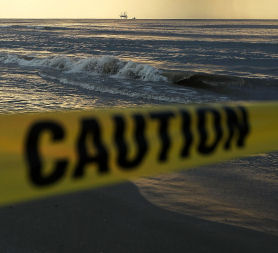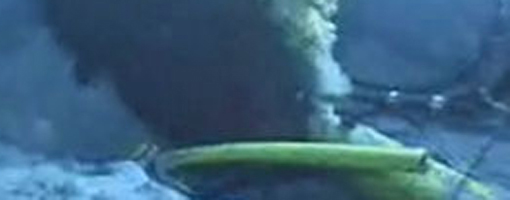BP begins 'top kill' as biologist sounds warning
Updated on 26 May 2010
As BP begins to use 'top kill' to plug the Gulf of Mexico oil spill, renowned marine biologist and veteran of previous man-made disasters, Professor Rick Steiner, spells out to Channel 4 News the harsh lessons that must be learned.

Prof Steiner, who studied the 1989 Exxon Valdez disaster – regarded as one of the most harmful environmental disasters in history – believes oil is "the devil's excrement" and attempts to clean up the Gulf of Mexico spill are "a pretentious façade."
He tells Channel 4 News the "out-of-sight" impact on nature of the spill will be "enormous", and that the disaster must prompt a move towards sustainable energy.
His comments come as the oil company BP attempts to plug the leaking oil well with a so-called "top kill" method today.
More on the BP oil spill by Prof Rick Steiner
- Oil disaster: is battle already lost?
- BP Gulf spill environmental costs ‘enormous’
- Deepwater: lessons to learn from the BP spill
Engineers armed with 50,000 barrels of dense mud and a fleet of robotic submarines today began a "top kill" manoevure to plug the gushing well a mile below the surface.
BP have given the procedure a 60-70 per cent chance of success, and US President Barack Obama has warned that there are "no guarantees".
Prof Steiner writes: "As a former oil minister in Venezuela dubbed it, oil is indeed 'el excremento del diablo' – the devil's excrement.
"But despite the destructive effects of our oil addiction, we still don't seem to want to seriously change our use of it."
Top Kill and Junk Shots - what it all means:
BP is pinning its hopes on stopping the flow of oil from its well in the Gulf of Mexico on a technique called Top Kill. Science Correspondent Julian Rush explains what it is.
There were some pretty snide comments made by US politicians when it emerged that BP planned to block the flow of oil from its ruptured well by firing golf balls, pieces of rope and bits of old rubber tyre into the pipe. But there was science behind the choice of objects.
Top Kill is a well established oil industry technique used to shut off broken wells. I watched it being used, for example, in the aftermath of the first Gulf War when Saddam Hussein's retreating Iraqi troops set fire to hundreds of oil wells in the Kuwaiti desert.
But it has never been tried before 5,000 feet under the ocean.
The idea is simple. Officially called "bridging material", the "junk shot" of golf balls and other objects is pumped down a pipe from the surface into a manifold that BP engineers are connecting to two valves - the Choke and Kill Valves - on the Blowout Preventer (BOP). That is the device on the seabed at the top of the well whose spectacular failure to automatically shut off the flow of oil when the Deep Water Horizon rig exploded in a fireball caused the spill.
Also in a chamber in the manifold is tonnes of heavy mud, called kill mud.
The manifold is like a loaded double-barrelled shotgun, the mud and the junk shot pumped to very high pressures.
First the junk shot is fired from one barrel into the BOP where it should lodge against the partially closed rams that should have closed fully to stop the flow originally. The golf balls and bits of rubber tyre are chosen carefully to be both flexible enough to catch and tangle inside the riser pipe in the BOP and small enough to effectively block it.
Immediately afterwards the second barrel is fired, sending the mud into the BOP up against the blockage made by the junk shot and down into the well underground. Once enough mud is pumped in the flow should stop, when the final step, of cementing the well to seal it completely can begin.
If it fails first time, BP says it can reload the manifold and try again several times. But if it doesn't work at all then the only hope is the relief wells they are drilling. That will mean another two months of oil gushing out before the well can be capped.
The 20 April Deepwater Horizon rig explosion killed 11 workers and triggered the oil spill in the Gulf of Mexico. Estimates vary, but it is feared up to 95,000 barrels of oil could be leaking into the ocean every day.
Prof Steiner wrote: "Horizon spill is huge, and perhaps already surpasses the largest accidental oil spill in history – the 1979 Ixtoc blowout in the southern Gulf of Mexico that spilled an estimated 130m gallons in the nine months it took to bring the blowout under control."
The effect of the leaked oil on wildlife has already been much publicised – with emotive images of Pelicans covered in oil beamed around the globe – but Prof Steiner believes attempts to clean up the mess are mainly futile.
He wrote: "Oil spill response and clean-up has never been effective, and a 10 per cent recovery rate is considered a 'successful' response by most experienced responders.
"It is a pretentious façade, that has never worked effectively. BP's statement that the environmental damage from the Deepwater Horizon disaster will be 'very, very modest,' is simply one of the most arrogant, ignorant, callous statements I have ever heard during a crisis such as this.
"The environmental damage from the Gulf spill has already been, and will continue to be, enormous. It is perhaps a conventional chauvinism of man to be more concerned about impacts we see on or near shore, but the greatest impact from this spill will with certainty be in the off-shore ecosystem.
Live video feed of the BP oil spill
BP is broadcasting a live video feed showing the leaking pipe along with a containment devise aimed at siphoning the oil to the surface where it is then stored in a drillship.
Click on the image to view the video stream
"This includes damage to dolphins, whales, sea birds, sea turtles, and so on. But significantly, the damage from this spill will be felt in the productive and critical pelagic ecosystem that to most people is out-of-sight, out-of-mind."
Amid reports that civil fines for the spill could be as much as $4,300 a barrel, on top of the government fines that BP and others could face, Prof Steiner believes the disaster will create a generation of legal action.
He wrote: "In the early days of the Exxon Valdez oil spill, I was told by oil industry insiders that 'lawyers yet to be born will work on this spill.' This unfortunately turned out to come true. The same may be the case for the Deepwater Horizon spill."
He adds this disaster should push the world towards a shift in energy sources.
He wrote: "Oil and other fossil fuels are finite resources; we are at or beyond Peak Oil (more than half of available global oil has been used already), and there is no longer any room for the additional carbon from fossil fuels in the global atmosphere and oceans. Fossil fuel companies know this, governments know this, Wall Street knows this, and all of us know this on some level.”





